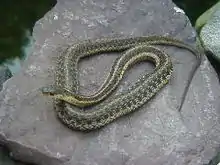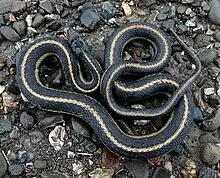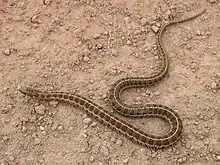Garter snake
Garter snake is the common name for small to medium-sized snakes belonging to the genus Thamnophis in the family Colubridae. Native to North and Central America, species in the genus Thamnophis can be found in all of the lower 48 United States, and nearly all of the Canadian provinces south of the Northwest Territories and Nunavut—with the exception of Newfoundland and Labrador. They are found from the subarctic plains of west-central Canada east through Ontario and Quebec; from the Maritime Provinces and south to Florida, across the southern and central U.S. into the arid regions of the southwest and Mexico, Guatemala and south to the neotropics and Costa Rica.
| Garter snake | |
|---|---|
 | |
| The eastern garter snake (Thamnophis sirtalis sirtalis) | |
| Scientific classification | |
| Domain: | Eukaryota |
| Kingdom: | Animalia |
| Phylum: | Chordata |
| Class: | Reptilia |
| Order: | Squamata |
| Suborder: | Serpentes |
| Family: | Colubridae |
| Subfamily: | Natricinae |
| Genus: | Thamnophis Fitzinger, 1843 |
| Species | |
|
35, see text | |
 | |
| Thamnophis distribution | |
| Synonyms[1] | |
|
Atomarchus, Chilopoma, Eutaenia, Eutainia, Phamnovis, Prymnomiodon, Stypocemus, Tropidonote, Tropidonotus | |
With about 35 recognized species and subspecies, garter snakes are highly variable in appearance; generally, they have large round eyes with rounded pupils, a slender build, keeled scales (appearing ‘raised’), and a pattern of longitudinal stripes that may or may not include spots (although some have no stripes at all). Certain subspecies have stripes of blue, yellow, or red, mixed with black and beige-tan markings. They also vary significantly in total length, from 18 to 51 in (46 to 130 cm).[2]
With no real consensus on the classification of the species of Thamnophis, disagreements between taxonomists and disputed sources (such as field guides) are common. One area of debate, for example, is whether or not two specific types of snake are separate species, or subspecies of the same. Garter snakes are closely related to the genus Nerodia (water snakes), with some species having been moved back and forth between genera.
Taxonomy
The first garter snake to be scientifically described was the eastern garter snake (now Thamnophis sirtalis sirtalis), by zoologist and taxonomist Carl Linnaeus in 1758. The genus Thamnophis was described by Leopold Fitzinger in 1843 as the genus for the garter snakes and ribbon snakes.[3] Many snakes previously identified as their own genera or species have been reclassified as species or subspecies in Thamnophis. There are currently 35 species in the genus, with several subspecies in some of them.[4]
Habitat
Garter snakes are present throughout most of North America. Their wide distribution is due to their varied diets and adaptability to different habitats, with varying proximity to water. However, in the western part of North America these snakes are more aquatic than in the eastern portion. Garter snakes live in a variety of habitats, including forests, woodlands, fields, grasslands and lawns, but never far from water, often an adjacent wetland, stream or pond. This reflects the fact that amphibians are a large part of their diet. Garter snakes are often found near small ponds with tall weeds.
Behavior

Garter snakes have complex systems of pheromonal communication. They can find other snakes by following their pheromone-scented trails. Male and female skin pheromones are so different as to be immediately distinguishable. However, male garter snakes sometimes produce both male and female pheromones. During the mating season, this ability fools other males into attempting to mate with them. This causes the transfer of heat to them in kleptothermy, which is an advantage immediately after hibernation, allowing them to become more active.[5] Male snakes giving off both male and female pheromones have been shown to garner more copulations than normal males in the mating balls that form at the den when females enter the mating melee. A snake hatch can include as many as 57 young.[6]
Garter snakes use the vomeronasal organ to communicate via pheromones through the tongue flicking behavior which gathers chemical cues in the environment. Upon entering the lumen of the organ, the chemical molecules will come into contact with the sensory cells which are attached to the neurosensory epithelium of the vomeronasal organ.
If disturbed a garter snake may coil and strike but typically it will hide its head and flail its tail. These snakes will also discharge a malodorous, musky-scented secretion from a gland near the cloaca. They often use these techniques to escape when ensnared by a predator. They will also slither into the water to escape a predator on land. Hawks, crows, egrets, herons, cranes, raccoons, otters and other snake species (such as coral snakes and kingsnakes) will eat garter snakes, with even shrews and frogs eating the juveniles.

Being heterothermic, like all reptiles, garter snakes bask in the sun to regulate their body temperature. During brumation (the reptile equivalent of hibernation) garter snakes typically occupy large communal sites called hibernacula. These snakes will migrate large distances to brumate. Garter snakes have been recorded actively seeking social agregations; creating an interesting sociality that may have other implications.[7]
Diet

Garter snakes, like all snakes, are carnivorous. Their diet consists of almost any creature they are capable of overpowering: slugs, earthworms (nightcrawlers, as red wigglers are toxic to garter snakes), leeches, lizards, amphibians (including frog eggs), minnows, and rodents. When living near water they will eat other aquatic animals. The ribbon snake (Thamnophis saurita) in particular favors frogs (including tadpoles), readily eating them despite their strong chemical defenses. Food is swallowed whole. Garter snakes often adapt to eating whatever they can find and whenever they can find it because food can be either scarce or abundant. Although they feed mostly on live animals they will sometimes eat eggs.[8]
Venom
Garter snakes were long thought to be non-venomous but discoveries in the early 2000s revealed that they in fact produce a neurotoxic venom.[9] Despite this, garter snakes cannot seriously injure or kill humans with the small amounts of comparatively mild venom they produce and they also lack an effective means of delivering it. In a few cases some swelling and bruising have been reported.[10] They do have enlarged teeth in the back of their mouth[11] but their gums are significantly larger and the secretions of their Duvernoy's gland are only mildly toxic.[10][12]
Evidence suggests that garter snake and newt populations share an evolutionary link in their levels of tetrodotoxin resistance, implying co-evolution between predator and prey.[13] Garter snakes feeding on toxic newts can also retain those toxins in their liver for weeks, making those snakes poisonous as well as venomous.[14]
Conservation status


Despite the decline in their population from collection as pets (especially in the more northerly regions, in which large groups are collected at hibernation),[15] pollution of aquatic areas, and the introduction of American bullfrogs as potential predators, garter snakes are still some of the most commonly found reptiles in much of their ranges. The San Francisco garter snake (Thamnophis sirtalis tetrataenia), however, has been on the endangered list since 1969. Predation by crayfish has also been responsible for the decline of the narrow-headed garter snake (Thamnophis rufipunctatus).[16] Many breeders have bred all species of garter snakes, making it a popular breed.
Species and subspecies
Arranged alphabetically by scientific name:
| Image | Name | Subspecies | Distribution |
|---|---|---|---|
.jpg.webp) | Aquatic garter snake, Thamnophis atratus (Kennicott, 1860) |
|
coast of Oregon and California. |
| Bogert's garter snake, Thamnophis bogerti Rossman & Burbrink, 2005 | Oaxaca, Mexico | ||
| Shorthead garter snake, Thamnophis brachystoma (Cope, 1892) | northwestern Pennsylvania and southwestern New York. | ||
 | Butler's garter snake, Thamnophis butleri (Cope, 1889) | northwestern Ohio, northeastern Indiana, the eastern portion of the Lower Peninsula of Michigan, and the adjacent extreme southern tip of Ontario, Canada. | |
| Goldenhead garter snake, Thamnophis chrysocephalus (Cope, 1885) | Mexico. | ||
| Conant's garter snake, Thamnophis conanti Rossman & Burbrink, 2005 | Puebla and Veracruz, Mexico. | ||
| Cope's mountain meadow snake, Thamnophis copei Dugès, 1879 | Mexico. | ||
 | Sierra garter snake, Thamnophis couchii (Kennicott, 1859) | California and Oregon in the United States | |
 | Blackneck garter snake, Thamnophis cyrtopsis (Kennicott, 1860) |
|
southwestern United States, Mexico and Guatemala |
 | Western terrestrial garter snake, Thamnophis elegans (Baird & Girard, 1853) |
|
central British Columbia, central Alberta, and southwestern Manitoba in Canada, Central United States |
 | Mexican garter snake, Thamnophis eques (Reuss, 1834) |
|
Mexico and in the United States (Arizona and New Mexico). |
 | Mexican wandering garter snake, Thamnophis errans H. M. Smith, 1942 | Chihuahua, Durango, Jalisco, Nayarit, and Zacatecas States of Mexico. | |
| Montane garter snake, Thamnophis exsul Rossman, 1969 | Mexico. | ||
| Fox's mountain meadow snake, Thamnophis foxi Rossman & Blaney, 1968 | Mexico. | ||
| Highland garter snake, Thamnophis fulvus (Bocourt, 1893) | Mexico, Guatemala, Honduras and El Salvador. | ||
 | Giant garter snake, Thamnophis gigas Fitch, 1940 | central California. | |
| Godman's garter snake,[17] Thamnophis godmani (Günther, 1894) | southern Mexico | ||
 | Two-striped garter snake, Thamnophis hammondii (Kennicott, 1860) | central California to Baja California, Mexico | |
| Liner's garter snake, Thamnophis lineri[18] Rossman & Burbrink, 2005 | Mexico. | ||
 | Checkered garter snake, Thamnophis marcianus (Baird & Girard, 1853) |
|
southwestern United States, Mexico, and Central America. |
 | Blackbelly garter snake, Thamnophis melanogaster (Peters, 1864) |
|
Mexico. |
| Tamaulipan montane garter snake, Thamnophis mendax Walker, 1955 | Mexico. | ||
| Southern Durango spotted garter snake, Thamnophis nigronuchalis Thompson, 1957 | Durango, Mexico. | ||
 | Northwestern garter snake, Thamnophis ordinoides (Baird & Girard, 1852) | California, Oregon, and Washington; in Canada, it is found in British Columbia | |
| Tepalcatepec Valley garter snake, Thamnophis postremus Smith, 1942 | Mexico. | ||
 | Western ribbon snake, Thamnophis proximus (Say, 1823) |
|
western United States, Mexico, and Central America |
 | Yellow-throated garter snake, Thamnophis pulchrilatus (Cope, 1885) | Mexico. | |
 | Plains garter snake, Thamnophis radix (Baird & Girard, 1853) | central United States as far north as Canada and as far south as Texas. | |
| Rossman's garter snake, Thamnophis rossmani Conant, 2000 | Mexico. | ||
| Narrow-headed garter snake, Thamnophis rufipunctatus (Cope, 1875) | Arizona and New Mexico, and in the Mexican states of Sonora, Chihuahua and Durango | ||
 | Ribbon snake, Thamnophis saurita (Linnaeus, 1766) |
|
Eastern North America |
 | Longtail alpine garter snake, Thamnophis scalaris (Cope, 1861) | Mexico. | |
| Short-tail alpine garter snake, Thamnophis scaliger (Jan, 1863) | Mexico. | ||
 | Common garter snake, Thamnophis sirtalis (Linnaeus, 1758) |
|
North America |
| Sumichrast's garter snake, Thamnophis sumichrasti (Cope, 1866) | Mexico. | ||
| Madrean narrow-headed garter snake, Thamnophis unilabialis W. Tanner, 1985 | Mexico. | ||
| West Coast garter snake, Thamnophis validus (Kennicott, 1860) |
|
Mexico. | |
In the above list, a binomial authority or a trinomial authority in parentheses indicates that the species or subspecies was originally described in a genus other than Thamnophis.
See also
- Narcisse Snake Dens
- List of snakes, overview of all snake families and genera
References
- Wright AH, Wright AA (1957). Handbook of Snakes of the United States and Canada. Ithaca and London: Comstock Publishing Associates, a division of Cornell University Press. 1,105 pp. (in 2 volumes). (Thamnophis, p. 755).
- Healey, Mariah. "Garter Snake Care Sheet". ReptiFiles. Retrieved 2022-04-18.
- "ITIS Standard Report Page: Thamnophis". www.itis.gov. Retrieved 2019-07-06.
- "The IUCN Red List of Threatened Species". IUCN Red List of Threatened Species. Retrieved 2019-07-06.
- Shine, R; Phillips, B; Waye, H; LeMaster, M; Mason, RT (2001). "Benefits of female mimicry to snakes". Nature. 414 (6861): 267. Bibcode:2001Natur.414..267S. doi:10.1038/35104687. PMID 11713516. S2CID 205023381.
- "Garter Snake facts".
- Skinner, Morgan; Miller, Noam (2020-04-15). "Aggregation and social interaction in garter snakes (Thamnophis sirtalis sirtalis)". Behavioral Ecology and Sociobiology. 74 (5): 51. doi:10.1007/s00265-020-2827-0. ISSN 1432-0762.
- "Garter Snake Care Sheet". Thamnophis.com.
- Zimmer, Carl (April 5, 2005). "Open Wide: Decoding the Secrets of Venom". The New York Times.
- Smith, Michael (September 2001). "Duverney's Glands and "Warm" Herping". Cross Timbers Herpetologist. Dallas-Fort Worth Herpetological Society – via Melissa Kaplan's Herp Care Collection.
- Wright, Debra L.; Kardong, Kenneth V.; Bentley, David L. (1979). "The Functional Anatomy of the Teeth of the Western Terrestrial Garter Snake, Thamnophis elegans". Herpetologica. 35 (3): 223–228. JSTOR 3891690.
- de Queiroz, Alan (September 27, 2010). "Garter Snakes". Online Nevada Encyclopedia. Nevada Humanities. Archived from the original on February 18, 2017. Retrieved December 29, 2016.
- Williams, Becky L.; Brodie, Edmund D. Jr.; Brodie, Edmund D. III (2003). "Coevolution of Deadly Toxins and Predator Resistance: Self-Assessment of Resistance by Garter Snakes Leads to Behavioral Rejection of Toxic Newt Prey". Herpetologica. 59 (2): 155–163. doi:10.1655/0018-0831(2003)059[0155:codtap]2.0.co;2. S2CID 18028592.
- Williams, Becky L.; Brodie, Edmund D. Jr.; Brodie, Edmund D. III (2004). "A resistant predator and its toxic prey: persistence of newt toxin leads to poisonous (not venomous) snakes". Journal of Chemical Ecology. 30 (10): 1901–1919. doi:10.1023/B:JOEC.0000045585.77875.09. PMID 15609827. S2CID 14274035.
- Zimmerman R (2013). "Thamnophis sirtalis ". Kids' Inquiry of Diverse Species. Animal Diversity Web. Retrieved November 5, 2016.
- Hammerson GA (2007). "Thamnophis rufipunctatus ". IUCN Red List of Threatened Species. 2007: e.T63990A12727179. doi:10.2305/IUCN.UK.2007.RLTS.T63990A12727179.en.
- Beolens, Bo; Watkins, Michael; Grayson, Michael (2011). The Eponym Dictionary of Reptiles. Baltimore: Johns Hopkins University Press. xiii + 296 pp. ISBN 978-1-4214-0135-5. (Thamnophis godmani, p. 102).
- Thamnophis lineri. The Reptile Database. http://www.reptile-database.org.
Further reading
- Conant R (1975). A Field Guide to Reptiles and Amphibians of Eastern and Central North America, Second Edition. Boston: Houghton Mifflin Company. xviii + 429 pp. + Plates 1-48. ISBN 978-0-395-19979-4 (hardcover), ISBN 978-0-395-19977-0 (paperback). (Genus Thamnophis, p. 157).
- Fitzinger L (1843). Systema Reptilium, Fasciculus Primus, Amblyglossae. Vienna: Braumüller & Seidel. 106 pp. + indices. (Thamnophis, new genus, p. 26). (in Latin).
- Goin, Coleman J., Goin, Olive B.; Zug, George R. (1978). Introduction to Herpetology, Third Edition. San Francisco: W.H. Freeman and Company. xi + 378 pp. ISBN 978-0-7167-0020-3. (Thamnophis, pp. 132, 156, 326).
- Powell R, Conant R, Collins JT (2016). Peterson Field Guide to Reptiles and Amphibians of Eastern and Central North America, Fourth Edition. Boston and New York: Houghton Mifflin Harcourt. xiv + 494 pp., 47 plates, 207 figures. ISBN 978-0-544-12997-9. (Genus Thamnophis, p. 426).
- Ruthven AG (1908). "Variation and Genetic Relationships of the Garter-snakes". Bulletin of the United States National Museum 61: 1–201, 82 figures.
- Schmidt, Karl P.; Davis, D. Dwight (1941). Field Book of Snakes of the United States and Canada. New York: G.P. Putnam's Sons. 365 pp., 34 plates, 103 figures. (Genus Thamnophis, p. 236).
- Stebbins RC (2003). A Field Guide to Western Reptiles and Amphibians, Third Edition. The Peterson Field Guide Series. Boston and New York: Houghton Mifflin Company. xiii + 533 pp., 56 plates. ISBN 978-0-395-98272-3. (Genus Thamnophis, pp. 373–374).
- Vandenburgh J, Slevin JR (1918). "The Garter-snakes of Western North America". Proceedings of the California Academy of Sciences, Fourth Series 8: 181–270, 11 plates.
External links
- González-Fernández, Andrea; Manjarrez, Javier; García-Vázquez, Uri; D'Addario, Maristella; Sunny, Armando (2018). "Present and future ecological niche modeling of garter snake species from the Trans-Mexican Volcanic Belt". PeerJ. 6: e4618. doi:10.7717/peerj.4618. PMC 5903425. PMID 29666767.
- Anapsid.org: Garter snakes
- Several pictures of a Mexican ribbon snake (Thamnophis proximus rutiloris)
- Plains garter snake - Thamnophis radix. Species account from the Iowa Reptile and Amphibian Field Guide
- Eastern garter snake - Thamnophis sirtalis. Species account from the Iowa Reptile and Amphibian Field Guide
- Descriptions and biology of garter snakes
- Genus Thamnophis at The Reptile Database